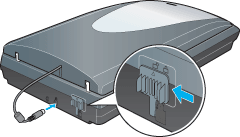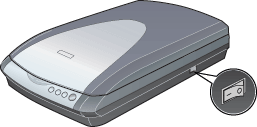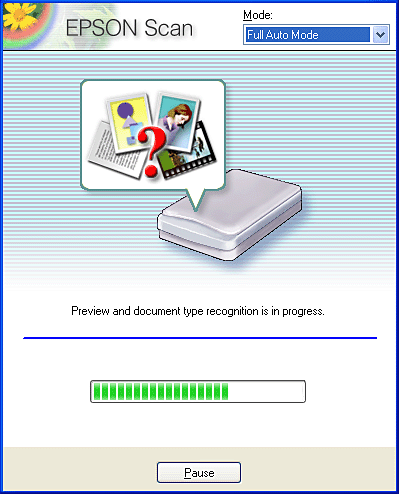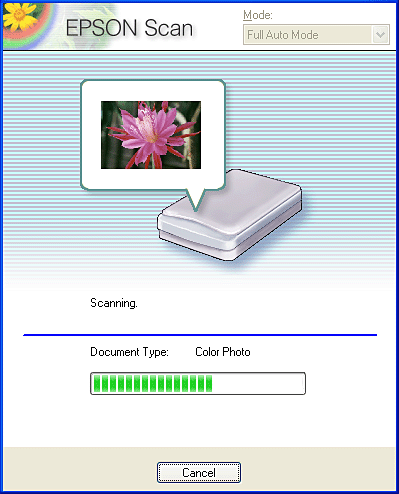|

Reference Guide
|
|
Basics Scanning Procedure
Scanning an Image
 Step1. Turning on the scanner
Step1. Turning on the scanner
 Step2. Placing your materials on the document table
Step2. Placing your materials on the document table
 Step3. Starting the software and scanning an image
Step3. Starting the software and scanning an image
 Step4. Saving the result as an image file
Step4. Saving the result as an image file
EPSON Scan provides four modes for you to make any scanning settings; Full Auto Mode, Home Mode, Office Mode, and Professional Mode. This section describes how to scan an image in the Full Auto Mode. The Full Auto Mode lets you scan images using automatically-adjusted settings. For more details, see Choose the Appropriate Scanning Mode.
 |
Note:
|
 | -
You cannot scan an image with a size that exceeds the available memory or disk space. If you try to scan the image, an alert appears on the screen.
|
|
 | -
The Office Mode can be used only when the optional Automatic Document Feeder is installed.
|
|
 |
Note for Macintosh users:
|
 | |
Most illustrations shown in this section are for Windows, so they may vary in appearance from what actually appears on your screen. The instructions are the same, except as noted.
|
|
 |
Caution:
|
 | |
Before starting the following steps, make sure that all the necessary software including EPSON Scan has been installed. For details about how to install the software, see the Start Here poster.
|
|
Step1. Turning on the scanner
 |
Before turning on the scanner, make sure the transportation lock is turned to the unlocked position and the scanner is connected to your computer. In addition, note that the cover cable is connected.
|

 |
Turn on the scanner. The  Start button light blinks, and then stays on in green, meaning the scanner has completed its initialization. Start button light blinks, and then stays on in green, meaning the scanner has completed its initialization.
|


[Top]
Step2. Placing your materials on the document table
You can scan two types of materials: reflective documents (like photo or paper) or transparent materials (like film). See the appropriate link below to set your materials on the document table.

[Top]
Step3. Starting the software and scanning an image
 |
Note for Mac OS X users:
|
 | |
Depending on your application, you may not be able to start EPSON Scan as described here.
|
|
You can start EPSON Scan in the following ways.
-
Start EPSON Scan directly as a stand alone application
-
Start EPSON Scan from a TWAIN-compliant application
This section provides you how to start EPSON Scan from Photoshop Elements. For details on the another way to start EPSON Scan, see Start Scanner Software (EPSON Scan) Directly.
 |
Note for Mac OS X 10.3 users:
|
 | |
Do not use the Fast User Switching function while using the scanner.
|
|
 |
Start Adobe Photoshop Elements.
|
For Windows users:
Click Start, point to All Programs (for Windows XP users) or Programs (for Windows Me, 98 SE, or 2000 users), and click Adobe Photoshop Elements 2.0.
For Macintosh users:
Double-click the Adobe Photoshop Elements 2 folder in Macintosh HD, and then double-click the Photoshop Elements 2.0 icon.
 |
Select Import from the File menu, and then choose EPSON Perfection 4180. EPSON Scan starts.
|
 |  |
Note for Windows XP users:
|
 |  | |
Do not choose WIA-EPSON Perfection 4180 from the menu to select the scanner. If you select it, you cannot use the EPSON scanner function fully.
|
|
 |
EPSON Scan automatically previews the image, and recognizes the document source and type.
|

 |  |
Note:
|
 |  | |
When you scan for the first time after installing the optional Automatic Document Feeder, a scanning mode other than the Full Auto Mode starts. This is because the Full Auto Mode cannot be used with the Automatic Document Feeder.
|
|
If you want to make more settings, click Pause and then click Options to open the Options dialog box. For more details on settings, see the Online Help by clicking the Help button in the Option dialog box.
 |
After EPSON Scan has previewed and recognized the document type, the following window appears. You can see the document type in the window.
|

EPSON Scan automatically locates the target images and modifies their skew, and then starts scanning.
 |  |
Note:
|
 |  | |
Be aware that clicking Cancel on this screen terminates EPSON Scan.
|
|
 |
The scanned image is sent to Photoshop Elements.
|
 |
Note:
|
 | -
Depending on the image you want to scan, you may not get the expected scanned image. In this case, scan the image in the Home Mode or the Professional Mode.
|
|
 | -
For information on further editing of the scanned images, refer to your application's documentation.
|
|

[Top]
Step4. Saving the result as an image file
After scanning an image, be sure to save it, following the steps below.
 |
Select Save As from the File menu in Adobe Photoshop Elements.
|
 |
Type a file name, select a file format, and then click Save. See the following section for the file formats.
|
File formats
The following table lists some common image file formats. Select an appropriate format supported by your image processing application when you save image files.
|
Format (File extension)
|
Explanation
|
|
BITMAP (*.BMP)
(Windows only)
|
A standard image file format for Windows. Most Windows applications including word processing applications can read and prepare images in this format.
|
|
EPS format (*.EPS)
|
A PostScript file format. Most illustration and DTP applications are compatible with EPS.
|
|
JPEG (*.JPG)
|
A compressed file format. The compression quality can be selected. The JPEG format enables relatively high compression ratio. However, the higher the compression ratio is, the lower the image quality becomes. (Note that the original data cannot be restored.) In addition, the quality deteriorates every time the data is saved. The TIFF format is recommended in cases where modification, retouch and the like are required.
|
|
Multi-TIFF (*.TIF)
|
A TIFF format where multiple pages are saved to the same file. To open the Multi-TIFF files, you need an application supporting this format.
|
|
PDF (*.PDF)
|
A document format that is independent of platforms. To use PDF documents, you need Adobe Acrobat Reader or Acrobat. When you save color or grayscale images in PDF, you can select a compression quality.
|
|
PICT (*.PCT)
(Macintosh only)
|
A standard image file format for Macintosh. Most Macintosh applications including word processing applications can read and prepare images in this format.
|

[Top]
| Version NPD0703-00, Copyright © 2004, SEIKO EPSON CORPORATION |
Step1. Turning on the scanner
Step2. Placing your materials on the document table
Step3. Starting the software and scanning an image
Step4. Saving the result as an image file